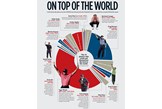Okay, here goes… we’re going to explain how golf’s world rankings work
Published: Last updated:
If you follow professional golf, you’ve probably found yourself, at one time or another, struggling to understand how the world golf rankings work. It can often seem nonsensical, particularly when players gain top spot in a week when they’ve missed the cut – or even just stayed at home. But there is a system. And it makes sense. You just need to get your head around it.

Changing hands six times in seven weeks
When the idea of this article was first discussed back in mid-August, Jordan Spieth was on the verge of taking over from Rory McIlroy at the top of the Official World Golf Ranking (OWGR). The young Texan achieved that by finishing runner-up to Jason Day at the US PGA Championship, while McIlroy finished down the field in 17th place. But no one could have predicted the rollercoaster ride that was to come as the title of World No.1 changed hands six times in just seven weeks.
McIlroy becomes world number one – without hitting a shot
Spieth’s initial reign was short-lived, lasting just two weeks before a missed cut at The Barclays enabled McIlroy to regain the lead without even playing in the tournament. The pair continued to exchange the top spot in unusual circumstances for the next three weeks. Then Jason Day joined the party.
Jason Day is the world’s best golfer – but only for one week
While McIlroy and Spieth were swapping turns at the top of the ranking without actually setting the world on fire with their golf, the Australian was tearing it up. Three victories in a five-week period from mid-August to the third week in September saw him reach number one for the first time. Day’s position at the peak of world golf only lasted one week, however, as Spieth rediscovered his game and his putting to dominate the Tour Championship, win the FedEx Cup and finish the PGA Tour season as World No.1.
As entertaining as this all has been to watch, it does beg the question: How and why did so many changes result and what, in particular, causes the anomalies of changes without the participants playing?

How are golf’s world rankings calculated?
The answer is, as you would probably imagine, rather complicated. In layman’s terms, however, the OWGR is calculated on a two-year rolling system, which awards and deducts points from a player’s tally each week. This means that during any given week, a player will receive points for their performance, while the points from two years ago are deducted. Despite missing the cut at the Deutsche Bank, Spieth lost fewer points than McIlroy, who would have needed a top-10 finish to stay number one. The following week, McIlroy’s loss was less severe than Spieth’s and so he was able to pass him again.
Who came up with the world rankings system?
The OWGR is the brainchild of Mark McCormack, the founder of IGM, and was introduced at the 1986 Masters at Augusta. Bernhard Langer was the inaugural World No.1 but he was quickly deposed at the top by Seve Ballesteros, and the German never regained his supremacy.
The world ranking is calculated over two years – not one week
During the past 30 years, the system has had several refinements in how the points are calculated, as Ian Barker of the OWGR explains. “It’s essentially an average of events played across the last two years, with the values of the points weighted,” he says. “As the performance becomes further in the past, it has less weighting applied to it so eventually the value decays right down to zero. The key fundamental to note is that it’s a perpetual system. It doesn’t stop and start like the Race to Dubai, for example, where everybody has zero at the start.
“In the world rankings, week 1 of a given year will be quite similar to week 52 of the previous year. What has to be built in is something so that players gradually lose points as well as gain them, and that’s where the weighted system comes in. All of the initial points won are kept on that player’s record for three months, or in system terms, 13 weeks. For the remaining 91 weeks, an equal fraction of that initial points value is lost every week, one divided by 92.
Striding for the top
“The way I often try to explain it is that it’s like you’re 13 strides away from the top of a stairway which has 91 steps and you take one stride every week. You’re at the same level for 13 weeks and then the 14th is the first stride down the staircase.”
A key factor in the calculation of the points is what is known as the divisor. This is a figure by which a player’s total points are divided, and it’s based on the number of events a player plays in. The figure ranges from 40-52, with 40 the minimum divisor.
You need consistency to be the best
“Imagine a player starting his career wins 10 points the first week and 20 the second, so he has 30,” Barker explains. “If you divided that by the two events played, he’d average 15 world ranking points, which would make him world number 1. That’s clearly not accurate.
“The final element is that the maximum divisor is the last 52 events a player has played, which protects those with heavier schedules. If you have played, say, 60 events, the system of points decaying makes it difficult for players to maintain an average. We found that players were skipping weeks in order for their divisor not to get too high so we changed it that the maximum number of events to count was 52.
Why missing an event sometimes boosts your ranking
“Because Rory didn’t play at The Barclays, he dropped one off his divisor which meant Jordan dropped points at a quicker rate. It’s like if you and I both played off a 9.4 handicap. If I didn’t play the next week and you played and missed the buffer zone, your handicap would increase by 0.1 whereas mine stays the same. So now I’m off nine and you’re playing off 10.”
Is there a better system?
Given the way the system has been streamlined since 1986, Barker doesn’t expect many more dramatic changes and believes that the current format is the best available to rank the top players.
“I’m sure there will continue to be refinements, but it has become very well established and accepted as a fair measure,” he says. “There will always be people who will argue that it could be improved – a lot of the criticisms will be, ‘They should do this,’ or ‘They should do that’ – but, from a position of not understanding the mechanics or the overall job of ranking in excess of 6,000 players.

Points mean prizes
“The biggest change that has happened in the last year has been the admission of some new ‘third-level’ tours and others are applying, so the net is always spreading. Nobody on those tours is going to get so high that people will say they shouldn’t be so high, but they see a reward. It also means there is extra publicity for those tours when the next great player shows signs of emerging.”








